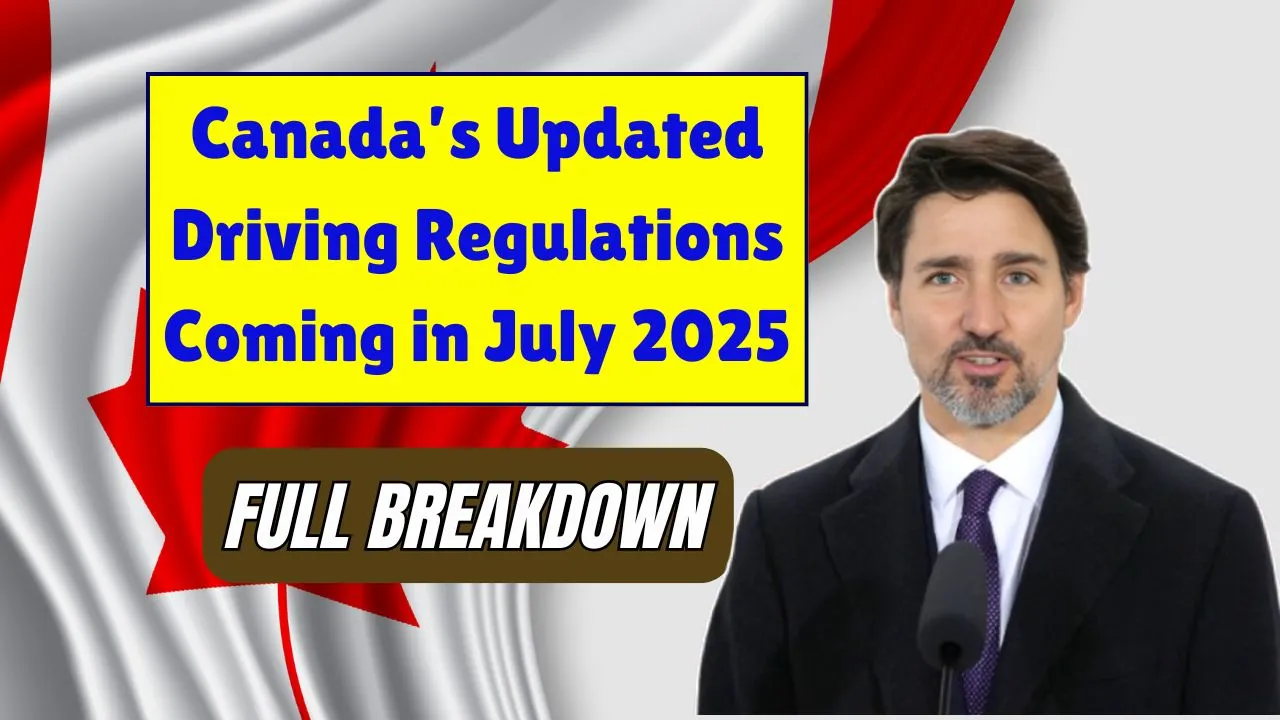Canada Driving Regulations July 2025: Starting July 1, 2025, Canada is rolling out a major update to its national driving laws. The new rules focus on boosting road safety, reducing environmental impact, and creating uniform standards across provinces. From tougher distracted driving penalties to mandatory eco-driving education, these changes aim to reshape how Canadians drive and how laws are enforced on the roads.
The Canada Driving Regulations July 2025 bring a combination of stricter fines, new training requirements, and technology-driven enforcement methods. These rules impact all types of drivers — from first-time license holders to commercial drivers — and touch on key areas like impaired driving, speeding, ride-share operations, and noise pollution. In this article, we provide a clear, practical overview of each change, how they’ll be enforced, and what drivers need to know to stay compliant.
Canada Driving Regulations July 2025
The Canada Driving Regulations July 2025 are set to reshape how driving laws function nationwide, impacting every category of motorist. These changes go beyond basic road rules and introduce modern solutions like AI enforcement, eco-focused education, and province-wide data sharing. Whether you’re a new driver preparing for your first license or a commercial operator navigating stricter compliance measures, understanding these new regulations is essential. The reforms aim to standardize enforcement across Canada while enhancing safety, environmental responsibility, and accountability for all drivers.
Canada Driving Regulations July 2025: Overview Table
| Policy Area | New Regulation |
| Distracted Driving | Ban on handheld devices; fines from $600; license suspension for repeat offences |
| Speeding Penalties | Zone-based penalties; higher fines in school/construction zones |
| Eco-Driving Education | Mandatory course for new drivers |
| Drug-Impaired Driving | Zero-tolerance for drivers under 21, novice, and commercial drivers |
| Exhaust Modifications | Ban on systems louder than 95 decibels |
| Interprovincial Data Sharing | Unified national driver database |
| Ride-Share/Delivery Drivers | New commercial classification; annual inspections and insurance proof required |
| Effective Date | July 1, 2025 |
| Official Source | Transport Canada |
Stricter Penalties for Distracted Driving
Distracted driving continues to be one of the top causes of accidents in Canada. Under the new regulations, holding a phone or device while driving will result in harsher consequences:
- First offence fines increase to $950.
- Demerit points rise from 3 to 5.
- Repeat offenders may face a 30-day license suspension within a 12-month period.
- AI roadside cameras will be deployed to automatically detect and report phone use behind the wheel.
These measures are designed to deter drivers from texting, calling, or using apps while operating a vehicle.
Speeding Reclassified Based on Zones
Speeding fines will now depend on the type of zone where the violation occurs. The goal is to protect vulnerable areas while giving provinces flexibility in rural settings.
- School zones, construction areas, and high-pedestrian regions will carry double penalties.
- Provinces may increase speed limits by 10 km/h in rural and low-traffic areas, depending on road safety evaluations.
This update balances safety with practical driving needs in different environments.
Mandatory Eco-Driving Course for New Drivers
A major environmental focus in the 2025 updates is the eco-driving certification course, which is now required for all new drivers. The course teaches:
- Techniques for fuel-efficient driving
- Best practices in vehicle maintenance
- Load management for energy conservation
Transport Canada estimates that this initiative could cut private vehicle carbon emissions by up to 12%. It’s part of a broader push to reduce environmental impact without banning private vehicle use.
Zero Tolerance for Drug-Impaired Driving
Driving under the influence of drugs — particularly THC — is a growing concern. The new rules introduce a national zero-tolerance policy for certain drivers:
- Drivers under 21
- Novice drivers with G1, G2, M1, or M2 licenses
- All commercial drivers
Saliva-based roadside testing will be used to detect THC. A positive result leads to:
- Immediate 7-day license suspension
- A $2,000 fine
The law reflects a firm stance on road safety, especially for younger and professional drivers.
Nationwide Ban on Aftermarket Exhaust Modifications
To curb noise pollution, Canada is banning aftermarket exhaust systems louder than 95 decibels. These rules aim to reduce noise in both urban and residential areas.
- Enforcement will include vehicle inspections and noise-detection sensors
- Repeat offenders can face fines up to $5,000 and possible vehicle impoundment
This regulation promotes peace in neighbourhoods and supports healthier communities.
Insurance and Demerit Integration Across Provinces
For the first time, provinces will share driver data through a national database. This means:
- Offences in any province will now show on your home province driving record
- Insurance companies will have access to complete records, encouraging fair pricing based on actual behaviour
This change creates a more transparent and accountable system for drivers, law enforcement, and insurers.
Tighter Rules for Ride-Share and Delivery Drivers
Ride-share and delivery services like Uber, Lyft, DoorDash, and Instacart are now subject to new commercial driver requirements:
- Drivers must register under the “Public Use Commercial Drivers” (PUCD) classification
- Annual vehicle inspections are mandatory
- Drivers must prove commercial insurance
- Completion of a certified road safety module is required
Companies will be held responsible for tracking and auditing driver compliance. These steps aim to ensure safety for passengers, customers, and drivers.
Frequently Asked Questions (FAQs)
Q1: Do I need to take any action to comply with the new laws?
If you’re an existing driver, review the new regulations. New drivers must complete the eco-driving course before getting their license.
Q2: How will the new distracted driving rules be enforced?
Enforcement will rely on AI cameras capable of spotting handheld device use. Citations are issued automatically.
Q3: Are the new speed limits the same everywhere in Canada?
Not exactly. While penalties are standard, provinces may adjust rural speed limits based on local decisions.
Q4: What is considered a violation of the exhaust modification rule?
Any aftermarket exhaust that exceeds 95 decibels is banned and may result in a fine or vehicle impoundment.
Q5: How will the interprovincial data-sharing system affect me?
Your driving history will now follow you between provinces. This means offenses committed anywhere in Canada may impact your insurance and driving record.
Final Thought
The Canada Driving Regulations July 2025 represent one of the most comprehensive overhauls of road safety and driver responsibility in recent years. These updates focus on reducing accidents, protecting vulnerable road users, cutting down emissions, and bringing consistency across all provinces.
Whether you’re a daily commuter, a parent with a new driver at home, or someone using ride-share services for extra income, it’s essential to stay informed. Compliance isn’t just about avoiding fines—it’s about contributing to safer, quieter, and more eco-friendly roads across Canada.
If this article helped you prepare for the coming changes, feel free to share it with others, and don’t forget to check your daily horoscope or explore more updates on driving and safety across the country.









